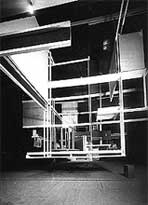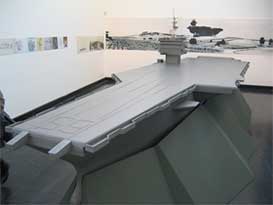The Austrian Pavilion at the Venice Biennale of Architecture is called Form, Raum, Net (shape, space, network), three terms that express the main ideas that have shaped our view of the city’s organization since early modernism. Without intending to imply completeness, by thematizing these terms reference is made to works by Austrian architects that have been capable of achieving a concise visualization of their era’s contemporary architectural discussion.
“Raum�? was illustrated by Frederick Kiesler‘s Raumstadt (1925); the “Form” of a city by Hans Hollein“>Hans Hollein’s Flugzeugträger (1964); and “Netz” was presented using the project that Gregor Eichinger developed specifically for the Biennale and which i failed to find exciting.
Like most of the visitors i was amazed by the “historical” part of the exhibition that showed two examples of Austrian urban utopia:

 City in Space and Aircraft Carrier City
City in Space and Aircraft Carrier City
Raumstadt/City in Space was part of Austria’s contribution to the Exposition des Arts Décoratifs in Paris in 1925. Influenced by the dramaturgy of stage, it features floating walls that are fixed neither to the floor nor to the ceiling, blurring boundaries between inside and outside.
The room near the entrance of the pavilion was filled with the model of aircraft carrier to evoke Hollein’s Aircraft Carrier City. A spectacular collage showing an aircraft carrier dugged in the middle of the fields creating a new city. The concept recalls Le Corbusier‘s use of a ship as a model for the city’s spatial complexity and economy. It is also a very in-your-face comment on the relationship between urban space and nature.

More information: Icon has an interview of Hollein. Images of Kiesler work.
